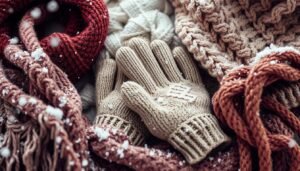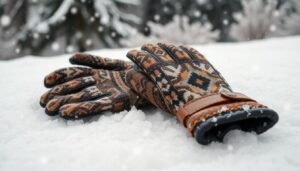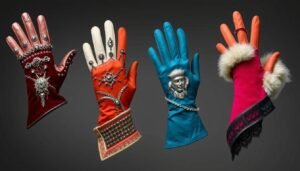When winter comes, picking the right gloves is key. Leather and fabric gloves both keep hands warm and safe. But which one is better for cold weather1? Let’s look into how gloves protect hands and find the best choice for winter.
Key Takeaways
- Leather gloves keep hands warm, even when wet, while fabric gloves are flexible and breathable.
- Gloves have insulation levels from 50-400 grams, affecting warmth and protection.
- Age, gender, and activity level influence how much heat we generate, guiding glove selection.
- Features like waterproofing, wind resistance, and dexterity are important for different winter activities.
- Keeping gloves in good condition, like conditioning leather, is essential for their long life and performance.
Understanding the Science of Hand Protection in Cold Weather
Keeping your hands warm in winter is key. The science behind it is quite interesting. Cold weather gloves trap your body’s heat, stopping it from escaping to the cold2. The materials used in gloves are crucial for keeping your hands warm and comfortable.
How Winter Gloves Trap Body Heat
Effective cold weather gloves trap your hand’s heat. They do this by using insulating materials that create a warm pocket around your hands2. Heated gloves can stay up to 82°F/28°C warm, while non-heated ones with hand warmers can reach 33°F/1°C2.
The Role of Materials in Temperature Regulation
Different materials insulate and regulate temperature in different ways. Leather protects against wind, while wool keeps heat in3. Synthetic materials like polyester and nylon are good at keeping warm and wicking away moisture4.
Fleece is a favorite for cold weather gloves because it’s light and wicks moisture4. Foams, both open-cell and closed-cell, offer varying insulation levels, with closed-cell being warmer because it traps air4.
Heat-reflective materials, like foil blankets, reflect heat back to the body. This is different from materials that trap warm air4. The right choice depends on the task and conditions, as too much insulation can make hands sweaty4.
Waterproof linings in gloves keep hands dry in wet or snowy conditions. However, this might make them less breathable and warmer4. Wind-proofing is also vital for winter gloves, as it stops warm air from escaping due to wind4.
Different glove styles, like mitts that block cold air between fingers, and gloves with liners for extra warmth, are important. They help balance warmth and dexterity423.
Leather Gloves: Benefits and Features for Winter Use
As winter arrives, keeping your hands warm is key. Leather gloves are a top pick for cold weather. They’re durable, flexible, and keep hands warm, making them great for many winter activities.
Leather gloves are also great at blocking wind5. They keep your hands warm while riding a motorcycle or working outside in the wind. Plus, they can be made waterproof, keeping your hands dry in the snow or rain.
The kind of leather matters too. Sheepskin leather is super warm and soft, perfect for very cold days5. Cowhide leather is strong and warm, great for outdoor activities in harsh weather5. Deerskin leather is flexible and water-resistant, keeping your hands agile and dry5. Peccary leather is luxurious, known for its softness, warmth, and fine craftsmanship5.
Leather gloves stay warm even when wet, unlike some synthetic materials5. They’re perfect for winter sports or outdoor work. Leather also lets your hands move freely, so you can do tasks easily.
In summary, leather gloves are a great choice for winter. They offer warmth, wind protection, and flexibility, meeting many cold-weather needs56.
“Leather gloves from Fratelli Orsini come in various styles, including warm linings like rabbit fur, cashmere, wool, and silk, as well as long leather gloves for women and white bridal gloves.”6
Fabric and Synthetic Materials in Winter Gloves
Winter gloves made from synthetic materials like polyester, nylon, and acrylic are gaining popularity. They keep hands warm and are often cheaper than leather7. These gloves are light, allowing for better movement, and dry fast, perfect for snowy or wet activities.
Popular Synthetic Materials Used
Polyester, nylon, and acrylic are top picks for winter gloves. They hold body heat well and are warm without being heavy7. Polyester stands out for its strength and flexibility, fitting into many glove styles.
Moisture-Wicking Properties
Synthetic gloves are great at keeping hands dry. They pull moisture away from skin, even in wet conditions7. This is key for skiing, snowboarding, or outdoor jobs where hands get wet.
Durability Factors
Though not as tough as leather, synthetic gloves are more affordable and easy to care for7. They often have reinforced areas for extra durability. Plus, they don’t crack or stiffen like leather can, making them a budget-friendly option.
| Glove Model | Overall Score | Warmth | Comfort & Dexterity | Weather Resistance | Features | Construction Quality |
|---|---|---|---|---|---|---|
| Carhartt Waterproof Insulated Men’s Winter Gloves | 78 | 10.0 | 6.5 | 9.5 | 5.5 | 6.0 |
| Carhartt Quilts Insulated Women’s Winter Gloves | 64 | 9.0 | 4.0 | 8.0 | 5.0 | 5.0 |
| Mechanix Wear Coldwork Original Unisex Winter Work Gloves | 71 | 6.0 | 9.0 | 4.5 | 8.5 | 8.0 |
| Kinco 1927KW Heavy Duty Work Gloves | 67 | 7.5 | 6.0 | 5.5 | 5.5 | 9.0 |
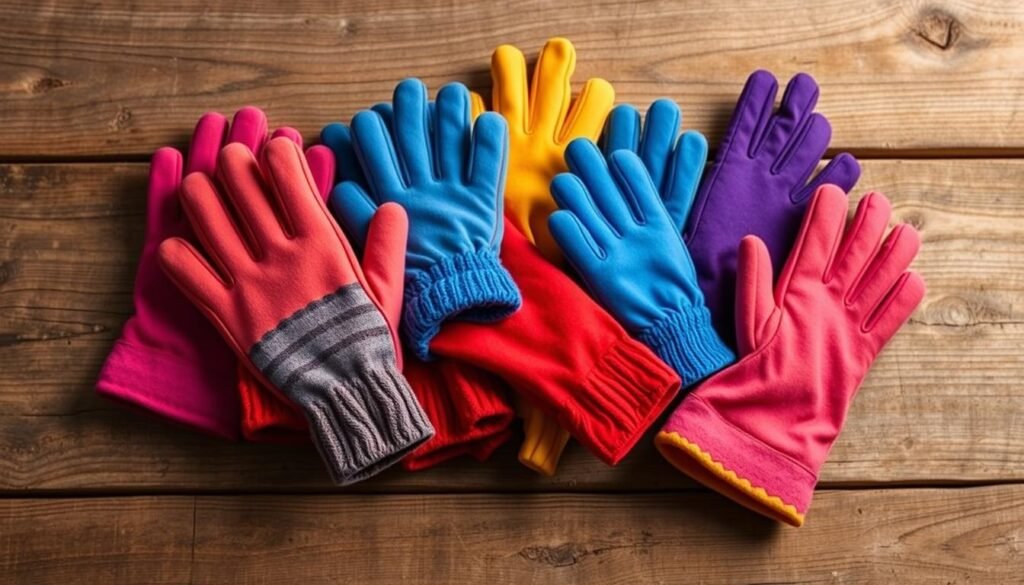
“Synthetic leather gloves are recommended for cold climates and heavy-duty work.”1
Best Types of gloves for winter: A Comprehensive Guide
Choosing the right gloves is key to staying warm in winter. Whether you’re outdoors or commuting, the best gloves balance warmth, dexterity, and weather resistance89.
For really cold weather, look for gloves with 150g Thinsulate™. The Arc’teryx Fission SV Gloves, an Editor’s Choice, keep hands warm without losing dexterity9. Leather gloves with fur or fleece lining, like the Outdoor Research Stormtracker9, offer a cozy touch.
Active winter fans might prefer synthetic gloves with advanced insulation. The Nathan Hypernight Reflective Convertible Mittens, with 88% polyester and 12% spandex Pro stretch material8, are perfect for running.
In milder winter, consider gloves with 50-70 grams of Thinsulate™ or fleece. The Castelli Perfetto RoS Gloves, with Gore-Tex Infinium and fleece8, are great for cyclists.
Waterproof gloves are a must for rainy days. The Carhartt W.P. Waterproof Insulated gloves9, at $30, are a good deal. They have a waterproof membrane and a nose wipe. The Outdoor Research Flurry Sensor9 is also handy for using touchscreens.
This guide helps you find the best gloves for extreme cold, outdoor activities, or everyday use8910.
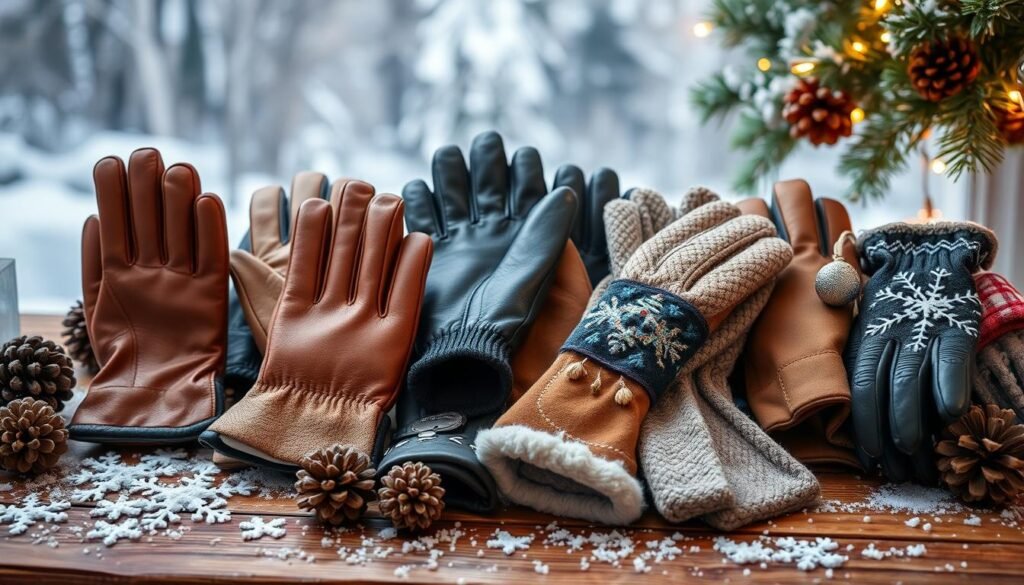
| Glove Type | Key Features | Recommended Models | Price Range |
|---|---|---|---|
| Extreme Cold Gloves | 150g Thinsulate™ insulation, waterproof | Arc’teryx Fission SV Gloves | $150-$200 |
| Luxury Leather Gloves | Fur or fleece lining, premium materials | Outdoor Research Stormtracker | $75-$150 |
| Active Winter Gloves | Advanced synthetic insulation, flexibility | Nathan Hypernight Reflective Convertible Mittens | $30-$50 |
| Moderate Cold Gloves | 50-70g Thinsulate™ or fleece lining | Castelli Perfetto RoS Gloves | $50-$100 |
| Waterproof Gloves | Waterproof membrane, reinforced palm | Carhartt W.P. Waterproof Insulated | $30-$50 |
| Touchscreen Gloves | Soft fleece interior, silicone grip | Outdoor Research Flurry Sensor | $40-$60 |
“The right winter gloves can make all the difference in keeping your hands warm and comfortable, no matter the weather or activity.”
Think about insulation, weather resistance, and dexterity when choosing gloves. This way, you’ll find the perfect pair for all winter8910.
Insulation Technologies and Thermal Properties
Winter gloves need the right insulation to stay warm and protected. Thinsulate™11 is a top synthetic material made by 3M. It uses tiny fibers that trap warmth better than materials like polyester or cotton.
Thinsulate™ comes in different weights, from 50 grams to 400 grams. The heavier ones keep you warmer in really cold weather11. The C40 model has a CLO rating of 0.7, while C100 and C200 have ratings of 1.3 and 2.5, showing their great warmth11.
Natural insulators like wool and down are warm but lose heat when wet12. Synthetic insulators, like Thinsulate™, work better when wet and dry faster. This makes them a better choice for winter gloves12.
Many gloves now use a mix of insulation types. This mix helps keep you warm, breathable, and dry in cold weather.
Natural vs. Synthetic Insulation
Natural and synthetic insulators have their own strengths. Wool and down are very warm but lose heat when wet12. Synthetic insulators, like Thinsulate™, stay warm when wet and dry faster. They’re a better pick for winter gloves12.
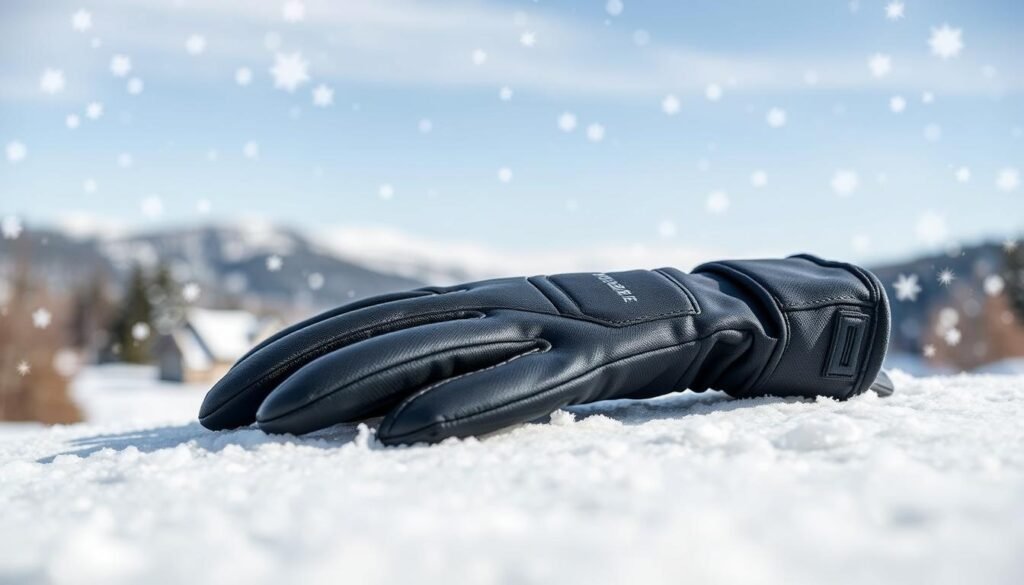
When picking winter gloves, think about the insulation and its warmth. Thinsulate™ and similar materials are great. They offer warmth, breathability, and moisture control for a cozy winter1112.
Waterproofing and Weather Protection Features
Winter gloves need to be waterproof, especially for snowy or wet weather13. Leather gloves, like those from deerskin or goatskin, are naturally water-resistant. They can be treated to make them even more waterproof13. Synthetic materials like nylon or polyester are light, dry fast, and cheaper than leather13.
For the best weather protection, look for gloves with waterproof coatings or layers. Gloves with extended cuffs that fit into jacket sleeves keep snow and cold air out. Some gloves have adjustable wrist closures to keep moisture and wind out14. In very cold and wet weather, gloves with a water-resistant outer shell and a moisture-wicking inner lining are best14.
| Feature | Benefit |
|---|---|
| Waterproof Coating/Membrane | Prevents water and snow from seeping in, keeping hands dry |
| Extended Cuffs | Provides additional coverage to seal out cold drafts and snow |
| Adjustable Wrist Closure | Helps to seal out moisture and wind for enhanced protection |
| Multilayer Construction | Offers comprehensive weather shielding for harsh winter conditions |
Choosing gloves with waterproof and weather-resistant features keeps your hands warm, dry, and safe. This is true whether you’re shoveling snow, building a snowman, or doing outdoor chores in the cold14.
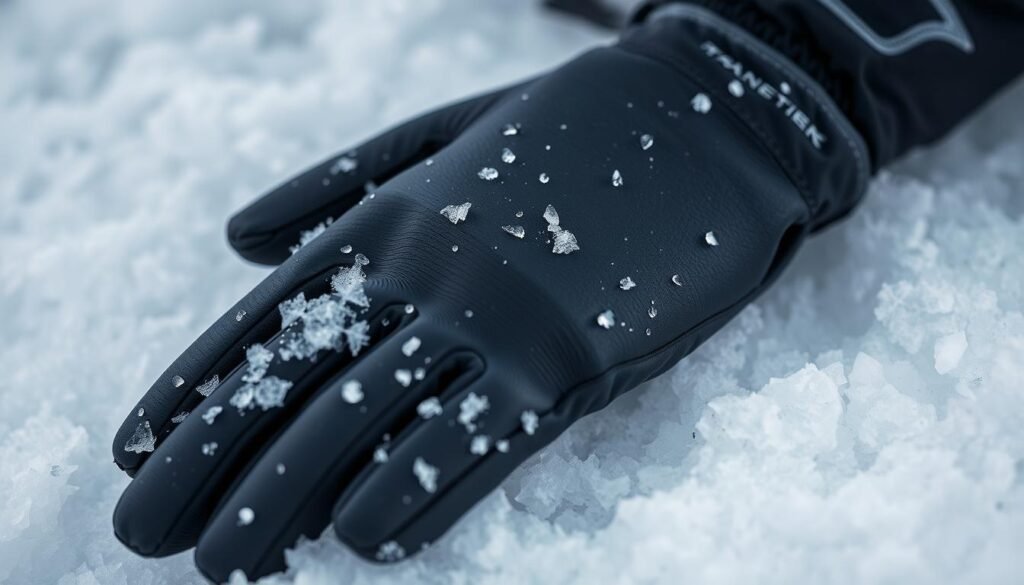
Choosing the Right Fit and Size for Maximum Warmth
Finding the right fit is key for keeping your gloves warm and working well. To measure your hand size, wrap a tape around your knuckles, skipping your thumb15. Look at the sizing charts from different brands, as sizes can differ. A good glove should let your fingers move a bit but not too much.
Wearing gloves that are too tight can cut off blood flow and make you colder. On the other hand, gloves that are too loose let cold air in, making you colder too16. Think about what you’ll be doing when choosing your glove size. For activities that need dexterity, a snug fit is better. But for really cold weather, a bit looser fit can be better with an extra liner.
Measuring Hand Size Correctly
- Wrap a measuring tape around the knuckles of your hand, excluding the thumb.
- Compare the measurement to the sizing chart provided by the glove manufacturer.
- Ensure a snug fit that allows for slight finger movement and traps warm air in the insulation.
Impact of Fit on Thermal Efficiency
17 Gloves that are too tight can cut off blood flow and make insulation less effective. Gloves that are too loose let cold air in, making you colder. The best fit is snug enough to keep warm air in but still lets your fingers move a bit.
| Glove Type | Recommended Fit | Insulation | Use Case |
|---|---|---|---|
| Outdoor Activity Gloves | Snug | Triple-layered with waterproof outer and insulation | Winter sports, hiking, and other outdoor pursuits |
| Everyday Gloves | Relaxed | Two-layer with waterproof outer and insulation | Daily wear, commuting, and casual activities |
| Dress Gloves | Tailored | Water-resistant leather | Formal occasions and professional settings |
“Ensuring the proper fit of thermal gloves is essential for maximizing warmth and comfort, especially in cold weather conditions.”
Maintenance and Care Tips for Winter Gloves
Proper glove care and winter gear maintenance are key to keeping your winter gloves in great shape. Whether they’re made of leather, fabric, or synthetic materials, a few easy steps can help. These steps will keep your gloves working well and your hands warm18.
For leather gloves, clean them with a damp cloth and use a leather conditioner. This keeps them soft and prevents them from drying out19. Most synthetic gloves can be washed in a machine on a gentle cycle. But, always check the care label first19. Let gloves air dry, away from direct heat, to avoid damage to the insulation or waterproofing18.
It’s vital to store gloves in a cool, dry place when not using them. This stops mold or mildew from growing19. For waterproof gloves, reapply water-repellent treatments now and then. Also, check gloves often for wear and tear, especially on fingers and palms. Replace them when needed to keep your hands safe18.
By following these easy maintenance and care tips, your winter gloves will last longer. You’ll have reliable hand protection all winter18.
| Glove Material | Cleaning and Care |
|---|---|
| Leather | Clean with damp cloth, apply leather conditioner |
| Synthetic | Machine wash on gentle cycle, air dry |
| Wool | Wash in cold water, use gentle detergent |
| Cotton/Polyester | Machine wash on gentle cycle, low heat dry |
Proper glove care and winter gear maintenance are crucial. They help keep your gloves looking good, working well, and lasting longer. By following these tips, your hands will stay warm and safe all season1819.
Conclusion
Choosing the right winter gloves depends on your needs, how active you are, and the weather20. Leather gloves are durable, windproof, and stylish. They’re great for outdoor activities and formal events. On the other hand, fabric and synthetic materials like Thinsulate or fleece keep you warm and dry20.
Think about the insulation, waterproofing, and fit for warmth and flexibility21. Good gloves make cold weather more comfortable, whether you’re outside or just going about your day22. Layering gloves or using a system of layers can also keep you warm and mobile22.
Your preferences, activity level, and the weather where you live are key to picking the best gloves202221. Knowing about hand protection and the options available helps you choose. This way, your hands will stay warm and safe all winter.
FAQ
Is it better to choose leather or fabric gloves for winter?
Choosing between leather and fabric gloves for winter depends on your needs and activities. Leather gloves are durable and keep out the wind. On the other hand, fabric and synthetic materials keep you warm and manage moisture well. Think about insulation, waterproofing, fit, and what you’ll be doing when picking your gloves.
How do winter gloves trap body heat?
Winter gloves create a barrier to keep your hands warm. They trap the body’s heat and prevent it from escaping. Different materials offer different levels of insulation and temperature control.
What are the benefits of leather gloves for winter use?
Leather gloves are durable, flexible, and naturally insulating. They’re great for windy and wet conditions. Different leathers, like sheepskin for warmth and cowhide for balance, offer unique benefits.
What are the popular synthetic materials used in winter gloves?
Synthetic materials like polyester, nylon, and acrylic are common in winter gloves. They’re good at keeping warm, wicking moisture, and are often cheaper than leather. Synthetic gloves are light, allowing for better movement and dry quickly, making them great for snowy or wet activities.
What are the best types of gloves for winter conditions?
The best winter gloves depend on your needs and activities. For very cold weather, look for gloves with 150g Thinsulate™ lining and waterproofing. Leather gloves with fur or fleece lining offer luxury and warmth. Synthetic gloves with advanced insulation are perfect for winter sports. For milder cold, gloves with fleece or 50-70 grams of Thinsulate™ provide warmth and flexibility.
What is Thinsulate™ and how does it compare to other insulation materials?
3M Thinsulate™ is a top synthetic insulator, offering warmth without bulk. It uses 15-micrometer fibers, denser than polyester or cotton. Thinsulate™ comes in various weights, with higher weights for colder weather. Natural insulators like wool and down are warm but lose effectiveness when wet. Synthetic insulators perform better in wet conditions and dry faster.
What are the key waterproofing features to look for in winter gloves?
Waterproofing is key for winter gloves, especially in wet or snowy weather. Look for gloves with waterproof coatings or layers. Extended cuffs and adjustable wrist closures help keep out snow and cold air.
How do I ensure the right fit for my winter gloves?
Finding the right fit is crucial for warmth and function. Measure hand size by wrapping a tape around the knuckles, excluding the thumb. Use brand-specific sizing charts, as sizes can vary. A good fit allows for slight finger movement without excess material. Consider your activity level when choosing fit – a snug fit is good for dexterity, while a looser fit can fit additional liners for extreme cold.
How do I care for and maintain my winter gloves?
Proper care extends the life and keeps winter gloves performing well. Clean leather gloves with a damp cloth and apply conditioner. Most synthetic gloves can be machine washed gently, but always check the label. Air dry gloves away from heat to avoid damage. Store them in a cool, dry place when not in use. For waterproof gloves, reapply water-repellent treatments to keep them effective.
Source Links
- https://www.wellslamont.com/resources/how-to-choose-the-best-winter-work-gloves/
- https://pmc.ncbi.nlm.nih.gov/articles/PMC5106465/
- https://www.heatholders.com/blogs/wow/the-ultimate-guide-to-choosing-thermal-protective-gloves-for-your-winter-wardrobe?srsltid=AfmBOoqFJi4lnyj9il3SRW6dr8ER8LaHtcXrjADiOISrzE2q_A4fZY_h
- https://ironclad.com/blog/winter-gloves-101/
- https://sullivanglove.com/blogs/news/leather-vs-wool-which-gloves-keep-you-warmer?srsltid=AfmBOoo9RMr4nmbS0tIqj7VP6TVx5agtgJnhfWaEH0FaLk4Bw1wKsC94
- https://www.fratelli-orsini.com/blogs/journal/benefits-of-leather-gloves
- https://www.heatholders.com/blogs/wow/the-ultimate-guide-to-choosing-thermal-protective-gloves-for-your-winter-wardrobe?srsltid=AfmBOopntJVDuDVZCzHAJXDX_GjLGbwCmqPIC144JXzHgLh4HXCd8nKz
- https://www.treelinereview.com/gearreviews/best-winter-gloves
- https://www.switchbacktravel.com/best-winter-gloves
- https://www.outdoorgearlab.com/topics/snow-sports/best-winter-gloves
- https://www.hexarmor.com/technologies/cold-weather
- https://solutions.borderstates.com/blog/thermal-winter-work-gloves-provide-quality/
- https://sullivanglove.com/blogs/news/best-gloves-for-winter-cc?srsltid=AfmBOorfDtQsAbtU0fY3ljiXgjf91xuS_o6JA5sBve2lXx0uxJRQQzkK
- https://trdsf.com/blogs/news/winter-work-gloves?srsltid=AfmBOopDTZ3lE1EfO42RloHlYub20Ws6vJgeEbz_z2WinzYmX62p9XFL
- https://jtillman.com/2021/05/04/choosing-the-right-winter-gloves/
- https://www.heatholders.com/blogs/wow/the-ultimate-guide-to-choosing-thermal-protective-gloves-for-your-winter-wardrobe?srsltid=AfmBOorcOaxJAMiVLe5hUO55oGFjGKr8s8J500UDgAf24xBCWBgvdEF4
- https://kosha.co/blogs/explore/hand-gloves-for-winter
- https://workglovesdepot.com/blog/proper-maintenance-and-storage-for-winter-gloves/?srsltid=AfmBOoodJq5waFfwvsfQW5KsKIVYW4LJnmkUU-41tvUj7FsJ7HoogVU4
- https://www.familyhandyman.com/article/how-to-clean-gloves-and-mittens/?srsltid=AfmBOoo_gLNgDwni_17QJoYKaEhPZ71_Q-J7tQr7YtxUvd1_UNUiW3c_
- https://www.heatholders.com/blogs/wow/the-ultimate-guide-to-choosing-thermal-protective-gloves-for-your-winter-wardrobe?srsltid=AfmBOopldKrfaBA7tetUz4uP_-oXlxuvcnXc_3q7ibAgSIJr2yYNygWk
- https://www.handlandy.com/blogs/articles/top-winter-gloves-to-keep-cold-and-moisture-out?srsltid=AfmBOopUGh_ToI_xJfhofWMl3jXcf5HX8–Ha1aNlrE5LXAeDDhvO3Oe
- https://pmags.com/glove-in-hand-layering-for-cold-weather

